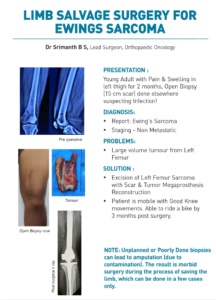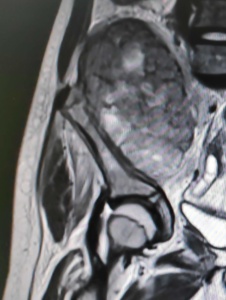Ewing’s sarcoma
Symptoms |Signs |Treatment
Ewing’s sarcoma is a round cell tumor, a component of the Ewing’s Sarcoma Family Of Tumours (EFTS).
What is the Incidence ?
- It is rare cancer
- But the second most common primary bone cancer.

Ewing’s Sarcoma of pelvis in Pediatric
What ages does it affect ?
- Seen in the age group of 5-20 years commonly.
- Adults are uncommonly affected.
What is the cause ?
- The etiology of Ewing’s sarcoma is evident as reciprocal translocation between chromosome 11 and 22 in 85 % of cases.
- EWSR1 and FLI1 fusion are identified in the majority of cases on Rt-PCR & FISH.
- Immunohistochemistry (IHC) identifies CD99, Fli-1 as confirmatory.
Which bones does it affect ?
- Long bones
- Pelvis
- Chest wall
- Spine, clavicle, hand and foot
- Extraosseous (Soft tissue) commonly seen in trunk and extremity
How is Ewing’s Sarcoma identified?
Ewing’s sarcoma | Symptoms | Signs | Treatment
- Symptoms
- Pain (Night Pain, Rest Pain)
- Swelling (Rapidly progressive)
- Masquerades as infection of bone in some instances with purulent discharge, may have fever as main symptom
- Pathological fracture due to trivial trauma
- In advanced cases, loss of weight , appetite
https://bonecancer.in/2020/05/01/arriving-at-diagnosis-services/
https://bonecancer.in/2020/05/01/biopsy/
- Tests
- Plain Radiograph
- MRI with contrast
- CT scan
- Image guided biopsy
- Whole body FDG PET CT scan
- Blood tests-LDH, ALP, ESR, CBC
- Nearly 75 % of individuals present with a solitary primary tumor without any distant metastases.
- Around 10 % of patients present with microscopically detectable bone metastases.
What tests are done on biopsy tissue?
- Histopathological evaluation
- Cytogenetic analysis
- Immunohistochemistry
- Flow Cytometry
What are the treatment Options ?
- The treatment of Ewing’s sarcoma is by a multidisciplinary team similar to osteosarcoma.
- Chemotherapy (Various regimens are used, 2 weekly interval Dose intense regimen is preferable)
- Preoperative
- Evaluation of Chemotherapy response by Imaging & Evaluation of specimen
- Postoperative
- Surgery: Limb salvage in 95% of cases.
- Type of Limb salvage surgery will be individualized.
- Rarely, amputation
- Radiotherapy: Effective is Ewing’s sarcoma.
- Often given as Post operative (Often based on size, operative margin)
- Rarely, as preoperative along with chemotherapy to shrink the tumour.
- Rarely, instead of surgery (Reserved for Non operable or High risk cases in pelvis, spine, sacrum and large size of primary tumor. Risk of recurrence is 10-20 %).
- High dose chemotherapy with stem cell rescue
- Targeted therapy, Immunotherapy
How is Limb Salvage possible in Ewing’s Sarcoma?

- Certain bones in our body are expendable and do not require any further reconstructive or salvage procedures like clavicle, rib, scapula, sternum, distal ulna and ilium.
- The cancer is removed En-Bloc with wide margins
- Reconstruction options include the same modalities as discussed in osteosarcoma which are individualized.
- These are Bone Grafts (Autologous or Allogeneic) which can be segmental (intercalary) or osteoarticular aided with implants
- Metallic Endoprosthesis (Megaprosthesis)
- Allograft-Prosthesis Composite (APC)
- Extracorporeal radiation and Re-implantation (ECRT)
- Vascularized fibula construct
- Allograft resurfacing.
- In children and adolescents who have tumors involving growth plate and residual growth remaining, an APC or Expandable Endoprosthesis (invasive or non-invasive) are performed.
- In individuals who have attained skeletal maturity, most common options are adult endoprosthesis and reconstruction using different modes of Bone grafts as outlined above.
- In case of involvement of shaft or diaphysis of long bones and pelvis, the removed tumor bone can be irradiated and reimplanted or substituted with allograft.
- Rehabilitation is provided according to the type of reconstruction.
What is the treatment for Metastatic disease?
- Most common site is Lung. Bone involvement is uncommon.
- A whole body fdg pet ct scan follows for staging.
- If an individual has distant metastases (lung most common), it can be surgically removed after removal of the primary tumor.
- If lung involvement is extensive then Radiotherapy to lung is provided
- Chemotherapy is necessary, but regimens of drugs may differ.
What are the rehabilitation steps involved post limb salvage?
- Rehabilitation post-surgery is dependent on the type of limb salvage.
- In case of bone graft reconstruction or APC, the involved limb is protected from bearing load or weight for a duration of 6 – 9 months to allow sufficient healing and bone graft incorporation.
- When endoprosthesis reconstruction is performed in pelvis and lower limbs, protected weight bearing and walking is allowed from the second postoperative day.
How often should I visit the doctor?
- The individual is followed up every 3 months for the first 2 years, followed by 6 months every 3 years (aggressive monitoring of the patient until 5 years).
- Overall survival of primary non metastatic Ewing’s sarcoma at presentation is 60 – 70 %.
- Distant metastases and local recurrence may necessitate change in chemotherapy protocol depending on the nature of event.
- Solitary metastasis and local recurrences require to be surgically removed.
- Survival of this specific category of individuals is 20-30 % at 5 years.
- Occurrence of multiple widespread metastases or multiple local recurrences increase morbidity and mortality risk.
Are there any prognostic factors for Ewing’s sarcoma?
- Stage of disease
Better prognosis is for primary tumor without metastasis
- Bone or Soft tissue involvement
- long bone involvement compared to pelvis and axial sites,
- small tumor size (less than 200 ml)
- children compared to adults
- lung metastases compared to bone metastasis
- response to initial chemotherapy surgery and radiotherapy
- Combination of Surgery and Radiotherapy
- LDH, Alkaline Phosphatase levels
- Gene changes
- Pathological Fracture
- In case of recurrence, the site and stage
For More Information CONTACT US


